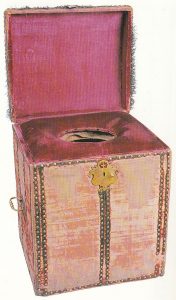The Groom of the Stool, or, as the official title was known, The Groom of the King’s Close Stool, has gone down in history as one of the grossest jobs available. As the name suggests the Groom of the Stool was responsible for attending to the King’s toileting needs. The Groom would care for the King’s toilet, known in the Tudor period as a ‘Stool’. He would be responsible for supplying water, towels and a washbowl for the King when he had finished his business. There is some debate as to whether or not the Groom of the Stool was responsible for wiping the King’s behind, with some believing he did and others thinking his duties did not extend to that extreme.
While being responsible for the King’s bodily functions may seem quite disgusting for us in today’s times when going to the bathroom is considered to be a private matter, it was very, very different in the Tudor age.
The Groom of the Stool was the highest position available in the King’s Privy Chamber. The King’s world consisted of the inner and outer chambers, the inner chamber also being known as the Privy Chamber. These chambers were a series of rooms, which included the King’s bedroom and waste closet. It was to these rooms that the King would retire to sleep, read and socialise in private.
The role first appeared under the rule of King Henry VII when he created the Privy Chamber in around 1495. At this time the role was considered to be simply attending to the King’s personal needs however under the rule of King Henry VIII, the position expanded greatly.
The King’s Privy Chamber was attended to by a series of men, at the head of these men was the Groom of the Stool. While attending to the King’s toileting needs the Groom of the Stool was also responsible for monitoring the King’s bowel movements and to liaise with doctors to ensure that the King was in good health and not suffering from any illness. Again while this may seem disgusting, it was vital that the King remain in good health so that he could rule the country with efficiency.
While initially the Groom of the Stool was responsible for attending to the King’s toileting needs, his duties and responsibilities expanded over time. During Henry VIII’s reign, the Groom of the Stool also became responsible for governing the men that tended the King in his Privy Chambers. He was also responsible for assisting the monarch in dressing and undressing, keeping track of the expenditures of the Privy Purse, ensuring the safety of the items within the Privy Chamber such as the King’s jewel and plate, and dictating who was and was not allowed to have access to the King in his personal chambers. The Groom of the Stool also took on the position of the King’s private secretary. Sir Anthony Denny, the King’s last Groom of the Stool, was also given the great responsibility of caring for the King’s dry stamp. This stamp was used to sign the King’s name to documents.
The Groom of the Stool naturally was granted lodgings wherever the King chose to reside and he was also given the King’s old clothes and furnishings. Again, while second-hand clothing might not seem that prestigious of a gift, keep in mind that the King’s clothing was always made of the finest materials, silks and furs. They were extremely expensive and would have been lavish items for the Groom of the Stool to own.
While the Groom of the Stool held no political influence, and he did not sit in on Privy Council meetings, he was still an extremely important and influential man. The role was highly sought after because of the proximity to the King. The Groom of the Stool was often about the King’s person and thus able to speak privately and intimately with the King. People would often petition the Groom of the Stool to pass on their matters to the King or perhaps to seek employment for members of their family. The Groom of the Stool could speak favourably or unfavourably of a person to the King during private situations and so it was vital to be on good terms with the Groom of the Stool.
Under the rule of Elizabeth I naturally it was not at all considered proper that a male should attend the Queen in her most private business. Therefore instead of the term Groom of the Stool, a Lady of the Bedchamber was appointed. Again she would attend to the Queen’s toileting needs as well as dressing and undressing and being responsible for the other ladies of the Queen’s Privy Chamber.
The last person to hold the title of Groom of the Stool was James Hamilton, 2nd Duke of Abercorn, who served Edward, Prince of Wales, the future Edward VII. However when Edward came to the throne, he abolished the position.
Men who served as Groom of the Stool under Henry VIII:
- Sir William Compton - He tragically died of sweating sickness in 1528.
- Sir Henry Norris - He was arrested in May 1536 for alleged crimes with Anne Boleyn and executed on Tower Hill.
- Sir Thomas Heneage - He served in this position from 1536 to 1546.
- Sir Anthony Denny - He became a close confidant of Henry VIII and was responsible for telling the King that he was dying on 27th January 1547.
Sarah Bryson is the author of Mary Boleyn: In a Nutshell. She is a researcher, writer and educator who has a Bachelor of Early Childhood Education with Honours and currently works with children with disabilities. Sarah is passionate about Tudor history and has a deep interest in Mary Boleyn, Anne Boleyn, the reign of Henry VIII and the people of his court. Visiting England in 2009 furthered her passion and when she returned home she started a website, queentohistory.com, and Facebook page about Tudor history. Sarah lives in Australia, enjoys reading, writing, Tudor costume enactment and wishes to return to England one day. Her biography of Charles Brandon, Duke of Suffolk, will be out very soon.
Sources
- Burns, William E. (2009) Brief History: Brief History of Great Britain, Infobase Publishing, New York.
- Byrne, Eugene (2013) Who was the last Groom of the Stool?, History Extra, viewed 26 February 2016, http://www.historyextra.com/qa/royal-jobs.
- Gywn, Peter J. (2011) The King’s Cardinal: The Rise and Fall of Thomas Wolsey, Random House, New York.
- Hutchinson, Robert (2005) The Last Days of Henry VIII, Phoenix, London.
- Johnson, Ben, Groom of the Stool, Historic UK, viewed 26 February 2016, http://www.historic-uk.com/HistoryUK/HistoryofBritain/Groom-of-the-Stool/.
- Starkey, David (2002) The Reign of Henry VIII: Personalities and Politics, Random House, New York.




awesome article, really enjoyed the read. been
a longtime lurker on your blog. 🙂
Wood furnishings has one thing really natural regarding it.
There is this sense of warmth, of nature and also of
elegance that can be be found in wood furniture.
Wood is birthed coming from the planet. It feeds the fire, disintegrates in to blows and ashes away.
It is really near the human existence on earth.
Might be that is actually why it resonates a great deal with us.
Might be actually that is actually why you still obtain that warm emotion when you touch a
wealthy mahogany workdesk.